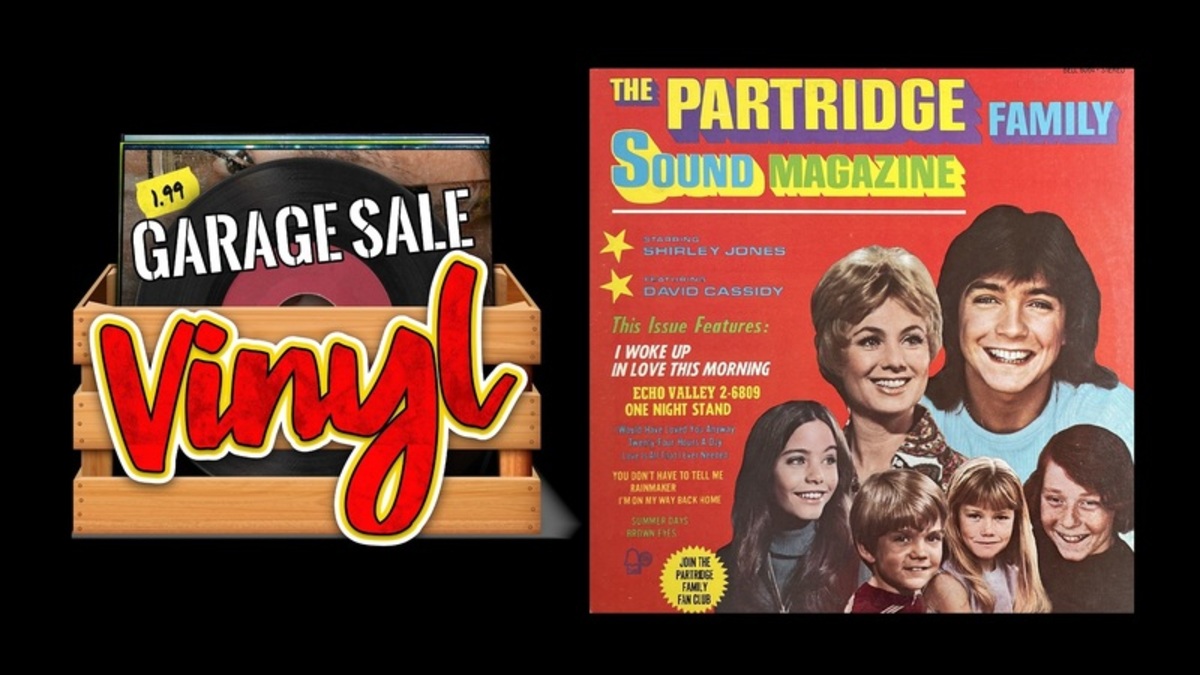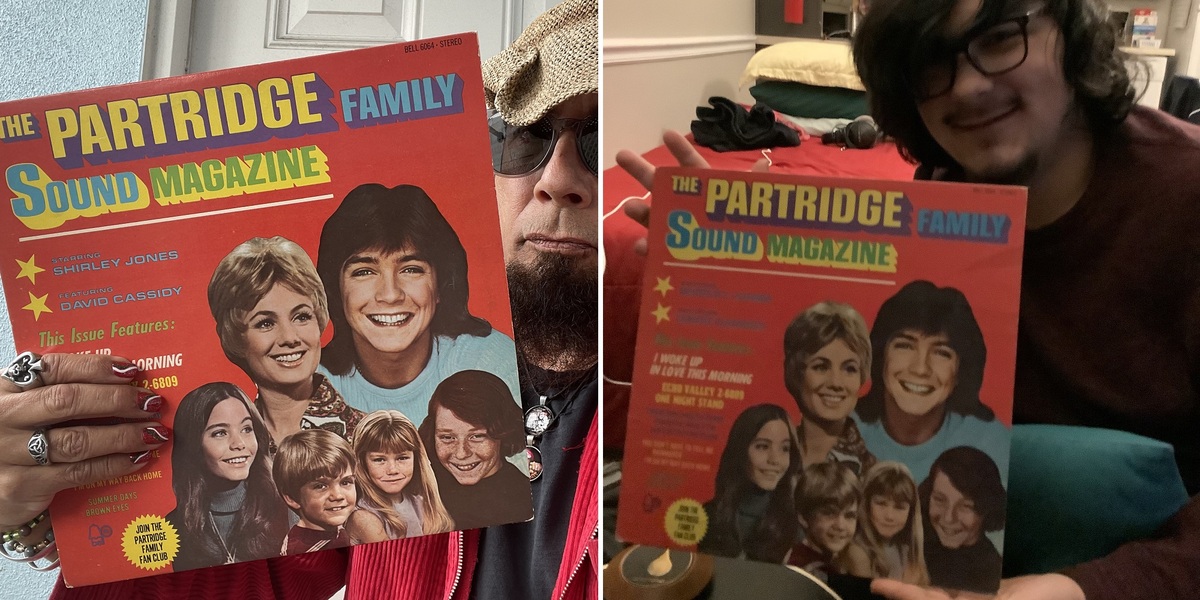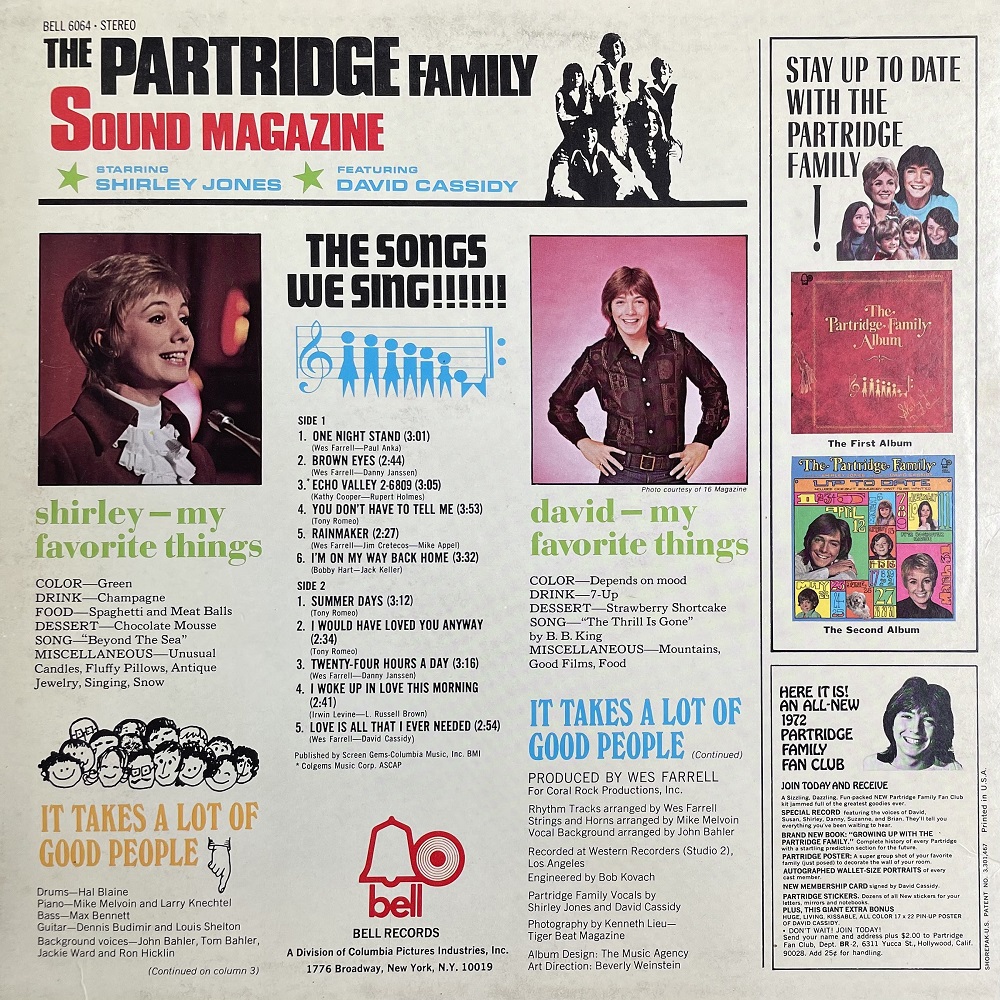
Garage Sale Vinyl: The Partridge Family
Sound Magazine / Bell Records / August 1971
by Christopher Long
What a zany year it’s been! Last Christmas, I reached out to my longtime Ink 19 editor, Rose Petralia, and asked if she had any interest in running a random mini-review of a 50-year-old Bonnie Raitt record that I’d discovered at a neighborhood garage sale, for a buck. She thought it was a cute idea. She further encouraged me to take the concept beyond merely a one-off piece. And in January 2023, Garage Sale Vinyl launched officially as a weekly Ink 19 column. Nearly a full year and 50 consecutive weekly installments later, “Garage Sale Vinyl” has blown up into my own cozy little music brand. In fact, my new book, GARAGE SALE VINYL: Rediscovering the Magic of Music… for a Song! will arrive in stores and at online retailers via Bibliozona Books in May 2024.
• •
Over the past 12 months, I’ve discussed each GSV installment in great detail with my old high school pal, former bandmate, longtime writing partner, and fellow vinyl enthusiast, Bryan Dumas. Although he’s known as “Richard” down at the DMV, his closest confidants call him “Dingus.” Anyway, Dingus and I have debated TWO very specific aspects of the modern-day vinyl lifestyle ad nauseam for some time.
Dingus is a music snob — a hopeless audiophile who only buys OLD “missionary position” black vinyl by tragic prog dinosaurs, whereas I’m a seasoned, forward-thinking gentleman who buys primarily NEW, factory-sealed, colored vinyl by pop-rockers on the rise. Dingus has tried convincing me numerous times of how vintage black vinyl is superior to current black (and colored) vinyl releases. He claims that from authentic musicianship to organic recording techniques to the actual manufacturing process, retro is best. Geez! What a dope! Everyone knows that newer ALWAYS is better, right? Well, um, guess who wound up being the dope?
Believe it or not, as the creator of a weekly column that’s ALL ABOUT vinyl records, I hadn’t owned a turntable personally since the early ’90s, until just recently. The GF and I would venture out together to various garage sales, thrift stores, and flea markets in pursuit of affordable vinyl treasures. Then, we’d spin ‘em down at her place, on her turntable. In fact, most of my vinyl prizes remained down at her place.
So, imagine my dismay and disappointment last week when I finally scored and set up my own new hi-fi (with turntable) at my own abode, only to discover that most of my shiny new (and very pretty), pink, purple, yellow, orange, green, red, white, and blue LPs sounded less than pristine — a smidge distorted, like there was dust build-up on the stylus. I’d noticed this frustrating factoid when playing some of the GF’s new colored vinyl on her home system. But I merely attributed it to her turntable being like Dingus: lame and outdated. But soon, I realized that even several of my newly-released black vinyl records also sounded less than pristine — compressed and often muffled-sounding.
Upon reporting this modern sonic annoyance to Dingus, he explained to me in a subtle, yet decidedly “I told you so” tone, that it wasn’t just my imagination running away with me. Apparently, when compared to old-school albums that were recorded (and produced) by humans, in analog studios with actual microphones and then mastered, properly, most new vinyl just doesn’t make the cut. Hmm.
Okay, Dingus was right about his vinyl perspectives, 100%. And I was wrong, all day long. But it takes a big man to admit when he’s wrong. So, in this final installment of my year-long Garage Sale Vinyl series, I wanted to offer one of the best and brightest examples that proves what industry experts now refer to frequently as “The Universal Dingus Theorem.” Or in layman’s terms, old vinyl is just better.
If people realized how little many of their worshiped crooners and idolized pluckers actually have contributed to their beloved platinum-selling records over the years, they might be less eager to dismiss and malign those old Partridge Family releases.

A now iconic sitcom, The Partridge Family was an early ’70s ratings winner about the adventures and misadventures of a wholesome, made-for-TV family pop band. Yet, despite the LP covers featuring the (non-musician) actors’ faces, Partridge Family albums were no less legit than most classic pop-rock chart-busters. The two lead vocalists for the TV troupe actually sang on those records. Widowed Partridge matriarch Shirley was played by award-winning stage and screen actress Shirley Jones, who also was an acclaimed songstress. Eldest Partridge sibling Keith was played by Jones’ real-life stepson — real-life feather-coiffed, golden god rock star, guitarist and songwriter, David Cassidy.
Those irresistible Partridge Family tunes were crafted fairly consistently by several of the leading songwriters of the day and were performed by some of the era’s most sought-after session players. Pulled primarily from the legendary Wrecking Crew, this team of qualified music vets played pretty consistently on most of the Partridge Family albums, including album #3, Sound Magazine, the 1971 stinger that’s regarded by many aficionados as their best work.
Overseen by celebrated producer and songwriter, Wes Farrell, Sound Magazine was a pure power pop tour de force, brimming with world-class songs and boasting George Martin-caliber production. Of the record’s slew of incredible session cats, renowned bassist Max Bennett and drummer Hal Blaine likely could have taken home co-MVP honors. Bennett’s badass grooves and sound were SO fat, SO real, it felt as if he was punching his way straight through the speakers. And whether it was a result of Farrell’s master production skill or Blaine’s total understanding of his instrument, he had THE perfect studio drum sound — from the snare crack to the kick pop to the tom tuning.
As a kid who craved all things Partridge related, I begged my mom to buy me the album (on vinyl, of course) the day it was released in ‘71. That copy would become battered and abused over the years. I replaced it with a CD reissue in the ’80s, and once again recently on inexpensive, reasonably well-cared-for 50-year-old vinyl. Instantly, I noticed how the sound quality of even slightly crackly vinyl, was FAR superior to the digital format, as if Max Bennett himself was playing live, right there in my cozy man cave.
As for the tunes, the Wes Farrell / Paul Anka songwriting collab “One Night Stand” was an urgent opener that revved into a heart-racing chorus. Honest, pure, and infectious, “Brown Eyes” was a prime example of a perfect early ’70s soft pop love song. Another highlight, “You Don’t Have to Tell Me” was driven by bluesy piano, crisp-sounding horns, and soaring orchestration, resulting in one of Cassidy’s all-time best studio performances. To this day, it’s still difficult for me to listen to this one and breathe simultaneously.
Most Partridge Family tracks followed a very specific formula, but it was a wonderful formula that worked every time. “My Way Back Home” was simply a happy-feeling song that hooked ya with textbook 101 pop-rock appeal, while the sunny-sounding “Summer Days” was accented by Brian Wilson-style “Good Vibrations” staccato strings. A bona fide “Cracker Jack prize,” the Top 20 hit “I Woke Up In Love This Morning” remains one of the Partridge Family’s two or three best-known, most loved songs.
In sum, Sound Magazine was, and still is an absolutely perfect pop-rock record. But to consume it in any format other than vinyl would be doing the record and the listener a HUGE disservice — touch the record, taste the music, and FEEL the sunshine. Heck, even Dingus’ 16-year-old chick magnet, Dingus Jr., owns and loves this one (on vinyl, of course).

I’m super grateful to everyone who has dropped by this past year and taken the time to read any or all of the 50 Garage Sale Vinyl installments. People have called me, messaged me, and even stopped me while out on the town to comment on this column and to offer me personal stories about their favorite records and recent crackly vinyl discoveries. That’s meant SO much to me.
Don’t forget to keep an eye out for Garage Sale Vinyl (the book), arriving next spring!
(5/5) ⭐⭐⭐⭐⭐

Sound Magazine Track List
SIDE ONE
- One Night Stand (Farrell, Anka) – 3:01
- Brown Eyes (Farrell, Janssen) – 2:44
- Echo Valley 2-6809 (Cooper, Holmes) – 3:05
- You Don’t Have to Tell Me (Romeo) – 2:53
- Rainmaker (Farrell, Cretecos, Appel) – 2:27
- I’m on My Way Back Home (Hart, Keller) – 3:32
SIDE TWO
- Summer Days (Romeo) – 3:12
- I Would Have Loved You Anyway (Romeo) – 2:34
- Twenty-Four Hours a Day (Farrell, Janssen) – 3:16
- I Woke Up In Love This Morning (Levine, Brown) – 2:41
- Love Is All That I Ever Needed (Farrell, Cassidy) – 2:54












